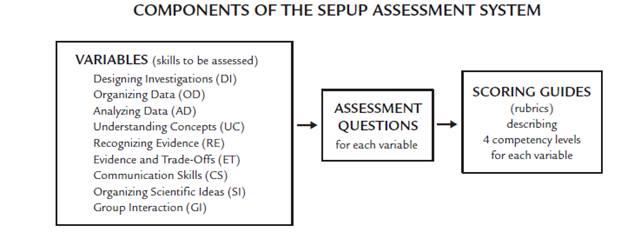A Year Viewed From Space
Assessment Plan
The materials used for instruction in this unit were developed by SEPUP (Science Education for Public Understanding Program). SEPUP materials provide a research based assessment system developed in cooperation with the Berkeley Evaluation and Assessment Research (BEAR) Group in the University of California Graduate School of Education. Research results have shown that students in classrooms who use the assessment system score better on post assessments than students who do not use the system (Wilson and Sloan, 2001).

DIAGNOSTIC EARTH IN SPACE UNIT ASSESSMENT:
- Completed at the beginning of the Earth in Space unit.
|
FORMATIVE ASSESMENT FOR THIS LEARNING EXPERIENCE: A YEAR VIEWED FROM SPACE:
- Following the completion of:
- Earth’s Year Viewed from Space: Side View, Earth’s Year Viewed from Space: Side View: Chicago, Illinois.
- Earth’s Year Viewed from Space: Side View: Melbourne, Australia.
- The student work was assessed using master copy of data and was scored on percent correct.
- A Year Viewed from Space Analysis Questions: (NOTE: The SEPUP rubric used to score the student work is indicated at the end of each question. A copy of the A Year Viewed From Space Scoring Rubric attached to student work is found in the appendix on pg.-----
- 1. What motion of Earth causes the yearly cycle of the seasons? (CS) (NYS 4.1.1c, 4.1.1i).
- 2. Why does a year on Earth have 365 ¼ days? (CS) (NYS 4.1.1e, 4.1.1h).
- 3. In which month(s) is Earth:
- A. Closest to the Sun? (CS) (NYS 4.1.1c).
- B. Furthest from the Sun? (CS) (NYS 4.1.1c).
- 4. Based on what you have observed about the distance from Earth to the Sun, does the distance from Earth to the Sun determine the seasons? Explain the evidence for your answer. (AD) (NYS 1.S32,d, NYS 4.1.1c, NYS 4.1.1i).
- 5. In what month is the Northern Hemisphere most tilted toward the Sun? (CS) (NYS4.1.1i).
- 6. In what month is the Northern Hemisphere most tilted away from the Sun? (CS) (PI 1.1i).
- 7. Explain how the tilt of the Earth affects the seasons and daylight. (UC) (NYS 1.S3.2d, NYS 4.1.1i,).
|
SUMMATIVE ASSESSMENT FOR EARTH IN SPACE UNIT:
- A four part unit assessment is given at the end of the unit that includes:
- Unit Project – Students work individually or in small group to analyze a mystery planet.
- Project presentation – Students present what they learned about their mystery planet to the class in poster or power point format.
- A written test.
- This portion of the summative assessment is scored on points
- Completion of My Ideas About A Day, Year, Seasons and Moon Phases: After.
|
As students are introduced to the various scoring rubrics used throughout the year they understand that these levels are converted to numeric grades for average purposes. Students receive a unit syllabus at the beginning of each unit indicating the questions/activities that will be graded for each lesson. After receiving feedback and a score, students are encouraged to make any necessary corrections to improve their score. When corrected work is submitted, it is rescored, amended in the grade book and returned to the student. Students are encouraged to continue to try to improve their work. All scored activities, regardless of unit, are then average for report card purposes at the end of each marking period.
Point Conversion:
Level 4 = 95
Level 3 = 85
Level 2 = 75
Level 1 = 65
